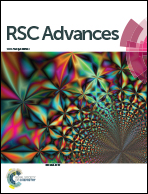Effects of oxygen on the structural evolution of polyacrylonitrile fibers during rapid thermal treatment†
Abstract
In this study, the mechanism of stabilizing polyacrylonitrile (PAN) fibers in a short period of time is investigated through probing the effects of oxygen on the structural evolution of PAN under different temperature regimes. It has been found that oxygen has a significant influence on both the chemical and physical structural evolution of PAN fibers, even in a short period of stabilization time, and the influences are dissimilar at different stabilization temperatures. At lower temperatures (below 140 °C), there is no noticeable change in the chemical and physical structures of the PAN fibers. In the mid-temperature range (140–200 °C), oxygen can slightly induce the cross-linking of PAN chains and result in a higher rate of decreasing crystallinity. When the main chemical reactions are initiated at higher temperatures (200–260 °C), oxygen is directly involved in the oxidation reaction of the PAN chains and facilitates cyclization and dehydrogenation. These reactions initiate in the amorphous regions of PAN fibers, and extend to the crystalline regions at elevated temperatures.



 Please wait while we load your content...
Please wait while we load your content...